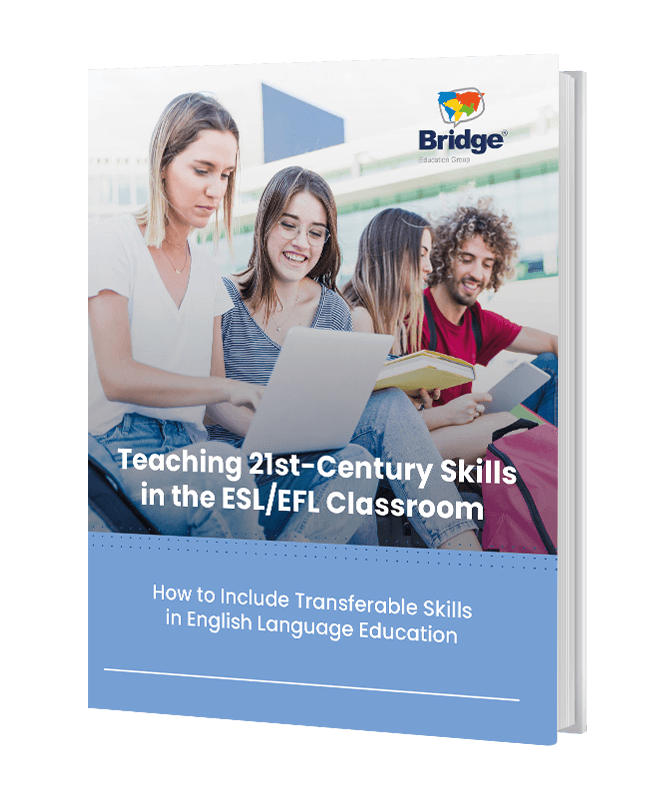Whether teaching in a physical classroom or a virtual one, the first day of English class is crucial for setting the tone for the whole term, so it’s important to start with a bang. ESL icebreakers are a great way to accomplish this, and they also get students moving and build confidence. However, icebreakers aren’t just for day one! Throughout the term, English students might be coming to class tired after a long day, so you want to get them engaged and energetic, and it might take a little creative ice-breaking to do that! Let’s take a look at some of the best ESL icebreakers out there.
If you’re new to teaching, you’ll want to get initial training and qualification with a TEFL certificate. You can explore our online TEFL courses to get started!
Why should I use ESL icebreakers in class?
First, let’s talk about how ESL icebreakers are beneficial in many classroom situations.
Get game and activity ideas for the online classroom by taking a Bridge Micro-credential course.
What makes a good ESL icebreaker?
It’s fun!
A good ESL icebreaker is, first and foremost, fun, meaning that it should appeal to your students. One of the main ideas behind icebreakers is to get students out of their shells and make them more comfortable with speaking in class, so you’ll need to use an icebreaker that interests them.
Try these fun ESL speaking activities to get students talking.
It’s level-appropriate
Make sure that the icebreaker you choose is level-appropriate and that while pushing students to share more, you don’t go overboard and make them uncomfortable by asking them to share too much or things that are too personal.
The rules are simple
Additionally, ESL icebreakers that only have a few rules are typically easier to explain to English learners and ensure that you spend less time going over instructions and more time actually conducting the activity.
It’s easy to prepare
Finally, a really good icebreaker doesn’t require too much preparation and additional materials but rather focuses on oral participation and fun.
These low-prep ESL activities are great for teaching online.
Begin your ELT journey or take the next step in your career with
Accredited Online TEFL/TESOL Certification
Explore CoursesESL icebreakers for in-person teachers (with adaptations for online teachers)
Each of the following icebreakers requires little to no preparation, is easy to explain, and can be adapted to all levels and ages. These activities promote student talk time and encourage students to become more comfortable with speaking up in class.

1. Would You Rather… ?
In this game, students think about two scenarios and choose the one they would rather do. The “Would you rather… ?” questions (a variety of which can be found online), can range from goofy to serious, such as:
You can play this as a whole class or put students in groups and give them a stack of cards with questions, and they take turns asking each other. Either way, following up by asking “Why or why not?” can lead to some fun discussions.
2. Two Truths and a Lie
This can be a good ESL icebreaker for the very first class or as a warm-up later on.
One student thinks of three statements about himself/herself that they will share with the class. Two are true and one is a lie. For example, the student may say something like, “I have five dogs, I’ve lived in three countries, and I’m a ballet dancer.” Then, the other students must guess which statement is a lie and if they can, explain why they think so. At the end, the student will reveal whether the others guessed correctly or incorrectly.
If used on the first day, the teacher can start by demonstrating the game as a good getting-to-know-the-teacher activity!
Check out these ESL warm-ups for students of all ages.
3. Positive, Negative, Crazy
Write a discussion topic on the board (for example, food, pets, social media, or dating) and then start passing a ball or “hot potato” from student to student. As students pass the hot potato around, they must stop when they hear you say the words positive, negative, or crazy.
When you say, “positive,” the student holding the potato must stop and make a positive statement about the topic. For example, If the topic is food, their statement might be “My favorite restaurant is Ichiban Sushi.”
If you say “negative,” they must make a negative statement about the topic, e.g., “I’ve never eaten Chinese food!”
And, if you say, “crazy,” the sentence they create can be anything they like, such as, “One time I ate a whole pizza myself!”
Strike up a conversation with these TEFL/TESOL discussion questions for adults.

4. Continue the Story
In this creative game, first think of several half-sentences and write each one on the top of its own piece of paper. The half-sentences should be written so that students can easily finish them to start a story, such as:
Alternatively, put these examples on the board and then have students each think of a half-sentence and write it on a piece of paper. Then, collect the papers and mix them up.
Students will then work in groups (or you can do this as a whole class). A group is given a paper with a half-sentence at the top and the first person in the group must read the half-sentence out loud, then finish it with whatever they like to continue the story (they will write it down and say it aloud). Next, the student passes the paper to his or her right and writes another sentence to continue the story.
When everyone has had a chance to contribute to the story, a representative of each group can read the completed story to the class. Not only can the stories be very funny, but this icebreaker gets students used to being more spontaneous with English.
Learn about the importance of storytelling in the ESL classroom for young learners.
5. The Hot Seat
This ESL icebreaker is a fun vocabulary guessing game.
Put a chair at the front of the room with its back facing the board; this is the hot seat, and a student volunteer must sit here. Then, write a word on the board (for beginners, tell them the category or theme of words, such as jobs or food – ideally vocabulary they are already studying). Then, the other students try to prompt the hot-seater into guessing what the word is by describing it without saying the actual word (fun with famous people too!).
For example, if you’ve told your beginner class the category is fruit and the word on the board is pineapple, the students can say things like:
With guessing games like this one, students are really enthusiastic about trying to get their peers to guess correctly and win the game. The desire to guess takes over, and formerly reserved students forget that they were ever afraid to speak up in English.
Get more ESL vocabulary games for teaching online and in-person.
6. Open-Ended Questions
Have students each write down an open-ended question on a piece of paper. The questions could be something like “What is your favorite holiday?” or “What kind of movies do you like?”
Students then either fold their papers or crumple them up into balls and drop them in a box as you pass it around. Then, go around the room and have students take turns drawing a paper from the box and answering the question. (Just be sure that students answer questions from their classmates, returning their own papers if they accidentally draw them.)
Ask follow-up questions if time allows.
You can easily tweak this activity for smaller classrooms with fewer students by having them each write three questions that have to be answered. You can also impose a speaking time limit, so students know how long they need to talk.

7. One Beep
This is a very simple ESL icebreaker that works well for any age and is a great way to practice English numbers.
Traditionally, students alternate between saying a number and the word “beep” as they go around the room counting. For example, the first student would say, “one,” the second would say, “beep,” the third would say, “three,” the fourth would say, “beep,” and so on.
However, you can make this game as complex as you want, such as choosing to insert “beep” for odd or even numbers, on numbers divisible by three, etc. You could also bring it to the next level by creating other sounds or words they have to say for certain numbers. For example, every number divisible by three must be replaced by “beep,” and every odd number must be replaced by “boop.” For numbers that fall into both categories, you must say both (“beep boop”).
Be creative and establish the rules based on your students’ level.
Need more creative TEFL/TESOL activities? Here’s how to use pop culture to teach English.
8. Interview and Introduce
This is an easy ESL icebreaker to incorporate on the first day of class (or later on if you feel students could get to know one another better). A benefit of this activity is that it removes the pressure of students introducing themselves at the start of class, which can sometimes cause stress for new students.
Simply break students into pairs and have them interview one another. To help students get started, give them a list of things to find out about their partner, such as where they’re from, how many siblings they have, or what their summer plans are for the upcoming year. Then, they will introduce their partners to the rest of the class.
9. Balderdash
This ESL activity, based on the game of the same name, works well for older and more advanced students.
Introduce a strange word that you’re sure they’ve never heard before (ask them to be sure that no one knows it, and make sure nobody looks it up!). Have each student write down a definition that they believe fits the word.
Collect all of the definitions and insert your own—the correct one—into the mix. Read off the definitions and have students vote on which they believe to be the correct one. Give points for students who guess correctly.
For teaching young learners, you could use this same idea to teach new, level-appropriate vocabulary or even to review past words that you’ve taught them.
10. Find Someone Who
This activity gets students up and moving around and asking their classmates questions.
Create a list of traits, such as someone who has a birthday in July, someone who owns a cat, someone who has traveled abroad, etc. Then, have the students mingle with one another to find someone who fits each category. They can write down the names of their classmates next to each one to keep track of who fits which trait.
If you add the rule that they can only use someone’s name for one category/trait, it will ensure that they get to speak with each of their classmates instead of simply talking to the one person who meets all the requirements.
Learn how to engage your older ESL students by taking Bridge’s Micro-credential course: Games and Activities for the Online Classroom (Adults).
Make transferable skills a part of every ESL lesson with the free
Guide to Teaching 21st-Century Skills in the ESL/EFL Classroom
downloadESL icebreakers particularly well-suited to online teaching
11. Show and Tell
Ask your student(s) to bring a meaningful object to class and share the story behind it with you and/or their classmates. If your student is a beginner, you can have them describe their object instead. E.g., “It is purple. It is big.” If you only have one student, consider asking them to bring in two or three objects total.
To get students comfortable with speaking and sharing, demonstrate the activity with an object of your own first.
Get more ideas for using realia in your classroom.

12. Scavenger Hunt
This activity works in both the physical and virtual classrooms and gets students up and moving, which is sometimes hard to achieve in an online classroom!
Provide students with a short list (3-5 items) of types of objects they need to find. E.g., something purple, something cold, something that starts with the letter B, something that makes you happy, something that was a gift, etc.
You can then see who can collect the objects from around their house or the classroom the fastest. Have students take turns sharing what items they found. If you’re teaching just one student, set a timer for five minutes (or whatever time you choose) and see if they can collect all of the required items before time runs out.
This activity is well suited to younger students and helps energize everyone at the start of class (or awaken everyone if the class starts to get a bit sleepy).
Looking for more ideas? Try these fun ESL games and activities for kids and teens.
13. Roll the Die
This is a great icebreaker activity, but it can also be used to practice pronunciation or review a group of vocabulary words.
Before class, you’ll need to create a special die for this icebreaker. You can repurpose a large plush die from a craft store, use a small, square-shaped cardboard box, or get creative here. Print off images that represent a certain action you want students to take, such as saying a word three times, saying it fast, saying it slowly, saying it loudly, whispering it, saying it in a low voice, saying it angrily, etc. For example, a picture of an angry emoji could represent saying the word in an angry voice.
Cut the images out and glue or tape them to each side of your cube. You now have your die!
In class, have your student(s) say a word or set of words that you choose. Roll the die and direct them to follow the instructions shown. This is a fun and silly way to get students out of their shells while helping them practice their English-speaking skills.
ESL icebreakers: An all-around win for the TEFL/TESOL classroom
ESL icebreakers are a great way to boost students’ energy, get them excited about the class, and build an atmosphere that makes them feel comfortable. Many icebreakers are also adaptable and can be used in both physical and online classes. While there are tons of icebreakers out there, the best ones are fun and engaging, promote speaking in English, and foster confidence.








